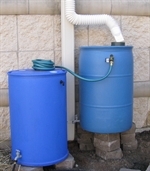
Photo by Abby Crisostomo
I witnessed something truly amazing this past Saturday, Sept. 29. What were once a couple of very sad and bare patches of lawn at the Paul Revere Primary and Intermediate Schools in Blue Island, Ill. were transformed into gorgeous native plant and rain gardens in just 10 hours! This is what happens when more than 120 teachers, students, neighbors and other people who care come together on a sunny Saturday in September, to do what is essentially stormwater management, with healthy doses of community engagement, school beautification, and Placemaking.
This event was one of several as part of our Blue Island, Blue Water project, an initiative to help one neighborhood in Blue Island combat serious local flooding and basement backup issues through native plant and rain garden plantings and rain barrel installations. Blue Island, Blue Water was recently named a model project for the Ill. Dept. of Natural Resources’ Millennium Reserve initiative.

MPC partnered with the City of Blue Island and the U.S. Green Building Council’s (USGBC) Green Apple Day of Service, through which a USGBC member, Lakota Group’s Daniel Grove, was assigned to help these schools design and install their garden. Many first-through-fifth grade students from the schools participated in the event, pushing wheelbarrows full of soil and getting their hands dirty putting plants in the ground. Several students exclaimed about how much fun they were having, and one said it was “the most fun she’d ever had in her life.” All of them said they would tell their fellow classmates all about the work that went into the gardens and what they were for, and most said they wanted to plant gardens to help with flooding at their homes, too. The kids’ energy and the adults’ sweat equity and dedication led to:
- new layers of groundcover to hide poor soil and gravel;
- 13 planter boxes (4 by 6 ft) built from scratch and filled with a mix of soil, sand and peat, in which each class will plant a garden to grow plants for students to take home;
- planting of nearly 900 plants in three separate gardens, including native plants, trees and shrubs;
- placement of several rain barrels at most of the school downspouts;
- delivery of 12 additional rain barrels to neighboring homes for installation on Oct. 6;
- dismantling of a retaining wall and reuse of the blocks as rain barrel platforms;
- and much more.

Designs become a reality after a long day of work.
Top right by Abby Crisostomo, all else by Daniel Grove
One thing we weren’t able to do was actually install the rain barrels. The school facility manager asked us to set them up the way we thought best so he could take a look the following Monday. He must have liked what he saw, because the schools (which together have more than 20 very large downspouts) are now bringing in a specialist to look at how to best disconnect the downspouts at both properties.
It was a long day and a lot of work, but as the sun began to and the last of the volunteers began to pack up to leave, I took a look at the garden design drawings taped up to the side of the school and remembered how ambitious we thought the plan would be for one day. We would have been happy to get even part of it done, but we actually succeeded in getting it all done!
As you can see from the plethora of great projects submitted to our Space in Between Placemaking contest (vote for your favorite by Oct. 5!), Blue Island isn’t the only community filled with creative and dedicated people ready to work. While it’s true that the possibility of bringing these amazing partners together again to replicate this exactly in other communities is not very likely, it is clear that the will is out there for everyday people to do these kinds of projects in their own communities, given the inspiration and opportunity. Some stormwater-specific opportunities for locals to get involved include the Milwaukee Avenue Green Development Corridor grant program in Logan Square in Chicago (apply for a grant now!) and MPC’s upcoming roundtable on neighborhood solutions to wetter weather (registration is open!) While we hope that the success of the Blue Island, Blue Water project will help the city secure stable funding to invest in public infrastructure, regardless, more than a hundred people went home with a little more ownership of their community and a much better understanding of how the ways we each use water are all connected.
See other photos and stories about the event:
The Power of Community - Green Apple Day of Service by Lakota Group's Daniel Grove
Green Apple Day of Service Success Stories by U.S. Green Building Council
Photos of the event from Jason Berry, City of Blue Island
Photos from Daniel Grove of the Lakota Group
Photos from Ania Ruszaj, Illinois Dept. of Natural Resources
Photos from Metropolitan Planning Council (Matt Nichols & Abby Crisostomo) and Cook County School District 130 (Stephanie Fordice)
The event at the Paul Revere schools and the other Blue Island, Blue Water projects are a collaborative effort of several organizations:
City of Blue Island
Blue Island Park District
Christy Webber Landscapes
Evangelical Community Church
Illinois Department of Natural Resources, Millennium Reserve
Illinois Environmental Protection Agency
Illinois Indiana Sea Grant
Lakota Group
Metropolitan Planning Council
Paul Revere Intermediate School
Paul Revere Primary School
University of Illinois Extension/South Suburban Cook County Master Gardeners
U.S. Green Building Council
And help from many more!